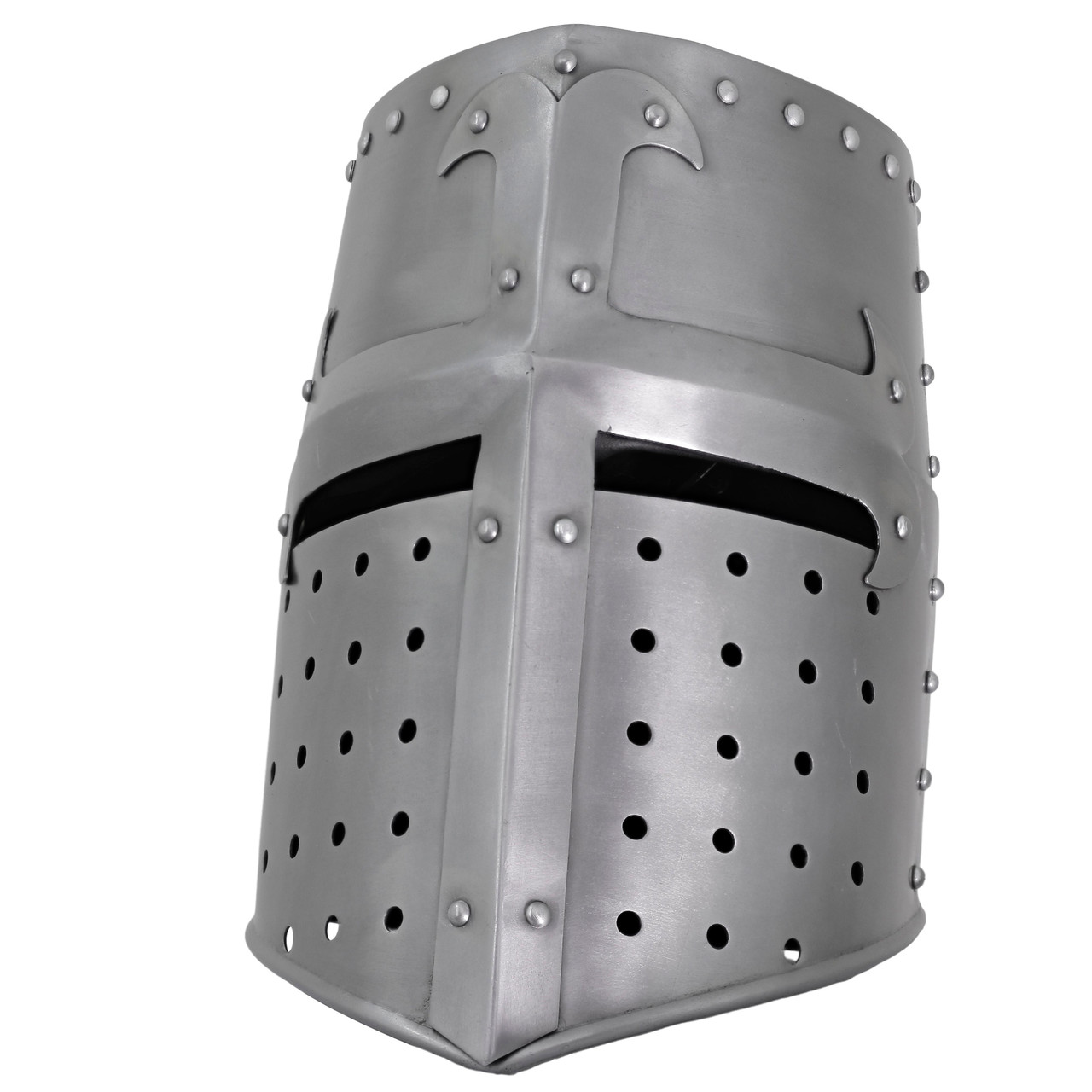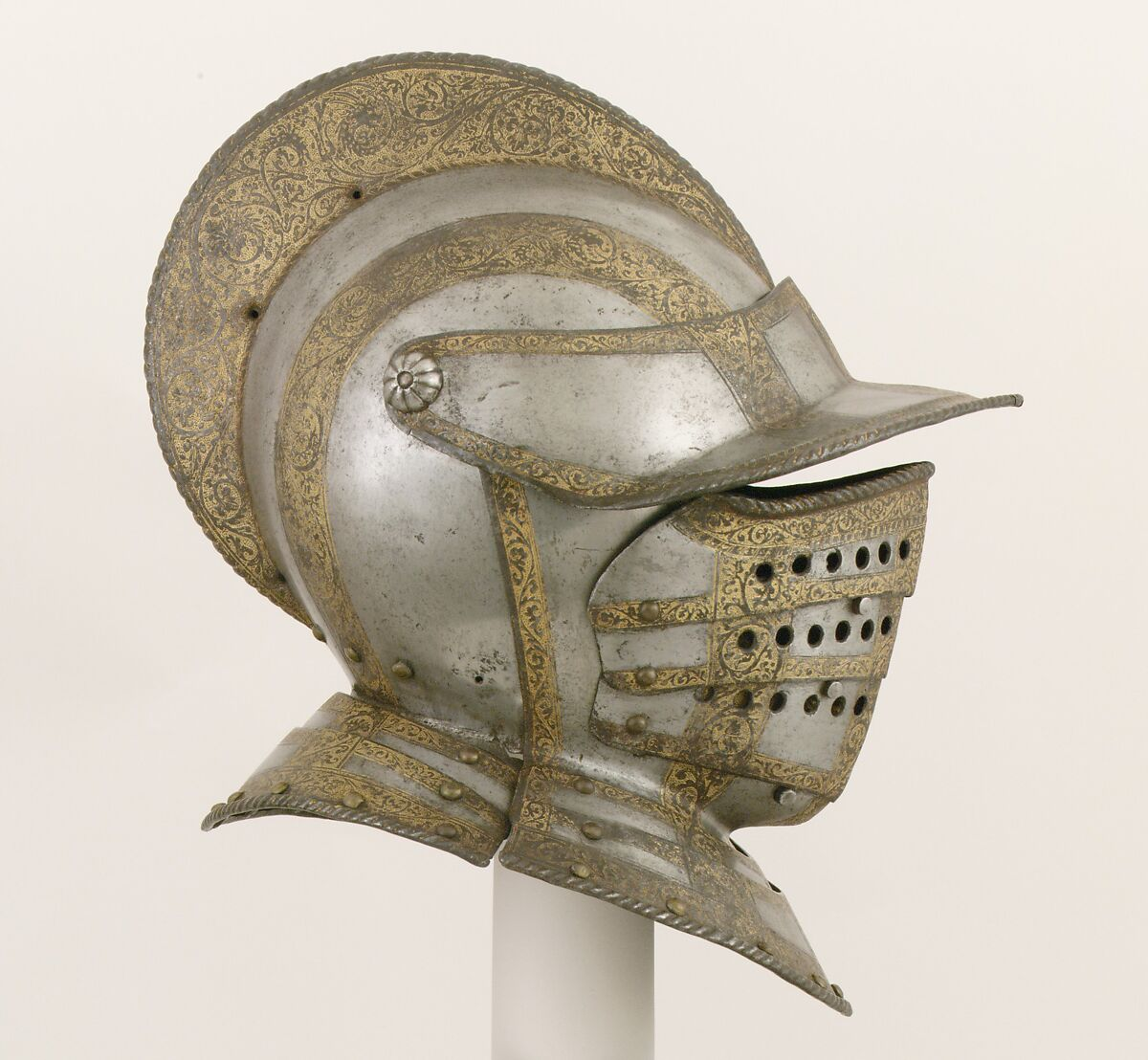Most Popular Medieval Helmets and How to Get One
Posted by Swordsswords on Feb 26th 2024
In the clash of steel and roar of battle, one piece of equipment stood between life and death: the medieval helmet . They evolved from simple nasals to the iconic Great Helm,. Throughout history, they remained testaments to engineering skill, social status, and the brutal realities of warfare.
Did you know that King Henry V's famous Agincourt Helm, dented and scarred, still bears the mark of combat even today? Let's delve into the fascinating world of medieval helmets and how to find them!

Most Popular Medieval Helmets
A. Great Helm:
Great Helm , also known as the "bucket helm," dominated the battlefield from the 12th to the 14th centuries. Its iconic design featured a cylindrical body completely enclosing the head, with narrow slits for vision and breathing. While offering excellent protection, its limited visibility and weight made it cumbersome. Initially crafted from thick plate steel, later versions incorporated lighter materials and improved ventilation. Great Helm symbolized the heavily armored knight, leaving an enduring mark on medieval imagery.
B. Bascinet:
Evolving from the Great Helm in the 14th century, the bascinet offered a more practical solution. This open-faced helmet, often combined with a mail aventail (neck protection), provided better visibility and mobility. Its key feature was the visor, a hinged piece that could be raised or lowered to protect the face during combat. Bascinets came in various styles, from the simple "skullcap" design to the "hounskull" with its distinctive ridge. The flexibility and affordability of the bascinet made it popular among both knights and foot soldiers throughout the late Middle Ages.
C. Sallet:
The sallet emerged in the 15th century, offering a unique blend of protection and style. Its design featured a bowl-shaped skull, often with a bevor (detachable face guard) and a tail extending down the back of the neck. The sallet 's lighter weight and increased peripheral vision made it ideal for mounted combat and jousting. Its distinctive design also became a canvas for elaborate decoration, reflecting the wearer's wealth and status. The sallet remained popular among both knights and light cavalry well into the 16th century.
D. Other Notable Greek Helmets:
While these three Greek helmets were prominent, the diverse needs of medieval warfare led to a variety of other interesting designs. The spangenhelm , with its nasal guard and segmented construction, was popular in the early Middle Ages. The burgonet, featuring a fluted skull and wide brim, offered protection well into the Renaissance period. Each Norman helmet type served a specific purpose, reflecting the ongoing evolution of warfare and medieval armour technology throughout the Medieval era.
Replica Helmets: Owning a Piece of History
Now that you've explored the world of medieval helmets , you might be wondering how to own a piece of history for yourself. Luckily, swordsswords.com is your one stop for all things medieval! We have a wide range of medieval swords and medieval helmets for sale !
When buying helmets online, two main options exist: historical replicas and theatrical reproductions.
Historical Replicas: These helmets are meticulously crafted to closely resemble their historical counterparts, using similar materials and construction techniques.
- Materials: High-quality replicas are typically made from 18 gauge steel or thicker, offering a balance between durability and weight. Leather is used for straps and padding, replicating the historical construction.
- Accuracy: Swordsswords prioritizes historical accuracy, ensuring the replica reflects the specific design, weight, and materials used in the original close helm.
- Safety: While these replicas aim for historical accuracy, safety remains paramount. Swordsswords ensures that our late medieval helmets have proper padding and additional safety gear for historical reenactment purposes.
Theatrical Reproductions: These roman helmets prioritize visual appeal over historical accuracy. They may be made from lighter materials like plastic or thin metal, and may not accurately reflect historical details. While more affordable, these helmets are not suitable for historical reenactment due to safety concerns and historical inaccuracies.
Choosing the Right Helmet:
When selecting a helmet , consider its intended purpose. If you desire an accurate representation of history, grab a historical replica from Swordsswords.com. If you're looking for a more affordable option for costume purposes, a theatrical reproduction might suffice.
B. Costume Helmets: A More Affordable Option
Costume helmets offer a more affordable alternative to historical replicas . Often made from lighter materials like plastic or fiberglass, they prioritize visual appeal over historical accuracy. This makes them ideal for cosplay, costume parties, or decorative purposes. However, it's crucial to remember that these helmets are not intended for combat or reenactment due to safety concerns.

Conclusion
From the imposing Great Helm to the versatile sallet , medieval helmets served not only as protection but also as symbols of status and innovation throughout the era. We've explored the most popular designs, each reflecting the changing needs and advancements in warfare.
Ready to claim your piece of history? Go to swordsswords.com NOW for a wide selection of medieval weaponry and body armor .
Grab the perfect medieval helmet to spark your imagination and ignite your passion for the past!

